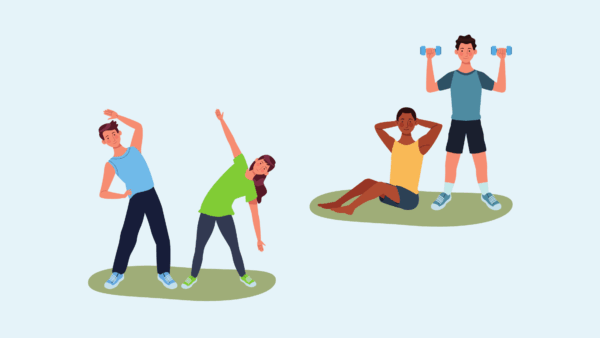
M.D. Medical Director, Psychiatrist
Many of us know about the physical benefits of exercise, but what about the mental health benefits? Keeping your body moving has been shown to improve mental health and reduce symptoms in depression and anxiety, as well as attention-deficit hyperactivity disorder (ADHD), and post-traumatic stress disorder (PTSD), amongst others.
In this article, we share what you need to know about mental health and exercise, including how exercise impacts mental health, and the connection between exercise and various mental health conditions.
Why does exercise make us feel good?
Ask most people why they exercise and they’ll likely tell you it’s because it feels good. Regular exercise can boost your mood, sharpen concentration, increase energy levels, and give you a more positive outlook on life. But why is that?
The relationship between exercise and mental health is a complex one. In some cases, being inactive can contribute to mental illness, but mental health problems can also make it hard to be physically active. Either way, research consistently shows that exercise has many benefits for emotional and psychological wellbeing.
Below are some mental health benefits of exercise:
- Relieves stress: Physical activity helps regulate stress-related hormones like cortisol. Over time, this not only reduces existing stress but helps improve resilience to future stressors. Research shows that more intense exercise can offer even greater protection against stress.
- Boosts mood: Exercise stimulates the release of brain chemicals like endorphins and serotonin, helping create feelings of happiness and relaxation. Even brief periods of movement, like 10 minutes a day, can help contribute to a more positive mood.
- Promotes better sleep: Regular movement can help you regulate sleep patterns, improve sleep quality, and reduce daytime sleepiness and insomnia. Exercise earlier in the day or relaxing evening activities like yoga can both support better rest.
- Improves self-esteem and confidence: Achieving your physical fitness goals, even small ones, can give you a strong sense of accomplishment and control. Regular physical activity has also been associated with improved body image and greater self-compassion.
- Sharpens memory and thinking: Exercise promotes better concentration, quicker thinking, and sharper memory. It stimulates the growth of new brain cells and helps prevent age-related cognitive decline, especially in adults over 50.
- Builds resilience: Exercising can make it easier to navigate mental or emotional challenges by providing healthy coping mechanisms and reducing reliance on harmful behaviors.
- Provides healthy distraction: Exercise offers a healthy way to distract yourself from negative thoughts and have new experiences
- Encourages social connection: Exercise classes or team sports offer a chance to socialize and interact with other people
- Releases physical tension: Physical activity reduces skeletal muscle tension and can help the body feel more relaxed
- Supports overall health: Exercise improves cardiovascular fitness and reduces the risk of developing chronic conditions like heart disease, diabetes, and arthritis, all conditions that people with mental health issues are at a higher risk of developing.
Before we get any further into the article, we want to make it clear that exercise doesn’t have to mean running a marathon or spending hours at the gym. Even modest amounts of physical activity can have powerful benefits for your mental health, whether it’s going for a daily walk, doing a yoga class, or just stretching at home.
Read: How Diet and Exercise Affect Your Mental Health
Exercise and depression
Regular exercise has been shown to significantly help manage symptoms of depression. Some of the most notable benefits include higher self-esteem, greater life satisfaction, and less negative thought patterns.
In one 2018 review, aerobic exercise was found to produce antidepressant effects. Activities like brisk walking, jogging, swimming, or cycling might help boost mood and emotional wellbeing.
There are many reasons why exercise can help with depression:
- Brain growth and resilience: Physical activity increases levels of brain-derived neurotrophic factor (BDNF), a key protein involved in learning, memory, and cell growth. Higher BDNF levels are associated with better mood regulation. In one 2023 review of 100 studies, it was found that prolonged high-intensity exercise was particularly effective in boosting BDNF and improving depressive symptoms, although research remains mixed on the ideal type and amount of exercise.
- Chemical balance: Exercise promotes changes in the brain, such as reduced inflammation and new neural activity patterns that enhance feelings of calm and well-being. It also triggers the release of endorphins, which are natural mood lifters that help energize and improve mental health.
- Distraction and mental reset: Physical activity also offers a healthy distraction from negative thought patterns, giving the mind time to reset and step away from the rumination that often accompanies depression.
In one 2019 study from the Harvard T.H. Chan School of Public Health, it was found that running for just 15 minutes a day or walking for an hour could reduce the risk of major depression by 26%. Maintaining an exercise routine has also been shown to help prevent depression relapse over time.
See: When to Get Help with Depression
Exercise and attention-deficit hyperactivity disorder (ADHD)
Research suggests that exercise can be a complementary treatment for attention-deficit hyperactivity disorder (ADHD) when combined with existing therapies. Regular physical activity has been shown to help regulate brain chemistry and improve core symptoms of ADHD in both children and adults.
Specifically, exercise has been shown to:
- Regulate dopamine levels: Physical activity increases dopamine, norepinephrine, and serotonin levels in the brain. These neurotransmitters all play a role in regulating focus, attention, and mood, and boosting their levels can help improve concentration and reduce hyperactivity and impulsivity. Exercise actually affects the brain in a similar way to ADHD medications like Ritalin and Adderall.
- Improve executive function: Executive functions include planning, organizing, and time management, all of which can be a challenge for individuals with ADHD. Research shows that exercise can support these cognitive skills and help improve daily functioning for those with ADHD.
- Enhance attention and focus: Several studies have found that regular aerobic activity can help improve sustained attention and reduce distractibility in people with ADHD.
Most research on exercise and ADHD emphasizes aerobic fitness (e.g. running, swimming, or cycling), but incorporating resistance training (like weightlifting or bodyweight) can provide additional mental and physical health benefits.
Read More: Tips for Managing Adult ADHD
Exercise and anxiety
Exercise can also complement treatment for generalized anxiety disorder (GAD). One 2021 review of studies found that exercise had a small but beneficial effect on reducing anxiety symptoms in individuals diagnosed with anxiety disorders.
Further research is needed to fully understand the extent of this benefit, but it’s widely accepted that incorporating regular movement in your daily life can be a valuable tool for managing anxiety. Exercise acts as a natural anti-anxiety strategy by:
- Relieving physical tension and mental stress
- Boosting endorphins and improving emotional well-being
- Increasing physical energy and resilience.
Any type of movement can help with anxiety, but mindful exercise can be especially beneficial. To do this, pay close attention to the physical sensations of movement, like the rhythm of breathing, the feeling of the muscles working, or the contact of your feet against the floor. This awareness can help ground your mind in the present moment and interrupt anxious thought patterns.
Exercise and stress
Stress affects both the mind and body. Physical symptoms include tense muscles, headaches, chest tightness, upset stomach, or sleep disturbances, and they can feed back into the stress response to create a cycle that’s difficult to break.
One way you can interrupt the stress cycle is through exercise. Physical activity stimulates the release of endorphins, the brain’s natural ‘feel good’ chemicals, while also helping physically relax tense muscles. When the body lets go of tension, you’ll find that the mind often follows.
Exercise and bipolar disorder
Exercise can also play a helpful role in managing symptoms of bipolar disorder, when used alongside medications and psychotherapy. Regular physical activity has been shown to improve mood stability, energy levels, and overall functioning.
In one 2020 study, it was found that regular exercise combined with nutritional support helped reduce depressive symptoms and improved functioning in people with bipolar disorder. However, researchers noted that more studies were needed to confirm these findings.
Some ways that exercise can help with bipolar disorder include:
- Managing medication side effects: Many medications commonly prescribed for bipolar disorder list weight gain as a potential side effect. Regular physical activity can help support a healthy weight.
- Reducing cardiovascular risk: People with bipolar disorder face a higher risk of developing cardiovascular disease. Incorporating exercise can help reduce this risk by improving heart health.
Learn More: What’s Bipolar Disorder? How Do I Know If I Have It?
Exercise and obsessive-compulsive disorder (OCD)
Exercise can also support obsessive-compulsive disorder (OCD) when combined with conventional treatment. One 2018 study found that aerobic exercise was associated with reduced anxiety and a decrease in compulsive behaviors amongst individuals with OCD.
That said, research in this area is still emerging and more studies are needed to explore different types of physical activity.
Exercise and post-traumatic stress disorder (PTSD)
In recent years, exercise has become a common part of PTSD recovery. Several studies suggest that regular physical activity can help reduce PTSD symptoms by:
- Desensitizing the body to internal arousal cues: Exercise helps you gradually become less reactive to the physiological sensations that often accompany anxiety and hyperarousal.
- Enhancing brain function: Physical activity supports brain health and emotional regulation by promoting the release of beneficial neurotransmitters and hormones.
- Regulating stress hormones: Exercise can help balance levels of cortisol and adrenaline, both of which play a role in the body’s stress response.
- Promoting neuroplasticity: Movement encourages the body to heal, adapt, and form new neural connections, which can help support trauma recovery.
Like with anxiety, it can be especially therapeutic for people with PTSD to focus mindfully on the body during exercise. Paying close attention to sensations like the feet hitting the ground or muscles stretching can help the nervous system move out of the ‘immobilization’ stress response often associated with trauma.
Physical exercise that engages both sides of the body, like walking, running, swimming, dancing, or strength training can be especially beneficial. Outdoor activities like mountain biking, rock climbing, hiking, sailing, and skiing have also been shown to reduce PTSD symptoms by combining physical movement with nature exposure.
How to develop an exercise routine for better mental health
We know it can feel overwhelming to start a new exercise routine, especially when life is already busy or mental health struggles make it hard to find motivation. The good news is that you don’t have to spend hours at the gym or even exercise to the point of exhaustion – even small amounts of movement can make a difference.
A little activity goes a long way
So, how much exercise do you need to feel good? Just 30 minutes of moderate physical activity five times a week is enough to see benefits for mental health. You can break this up into shorter sessions, like two 15-minute walks or three 10-minute stretches, if that’s easier to fit into your day.
If even 30 minutes feels too much, you can start with just 5 to 10 minutes of movement. The important thing is to exercise regularly. Over time, exercise will become a habit, your energy levels will increase, and it’ll feel easier to extend your activity sessions.
You don’t have to push yourself
Research shows that moderate intensity activity is best for most people. Moderate exercise means:
- Breathing a little heavier than normal but still being able to hold a conversation
- Feeling your body warm up as you move, but not feeling exhausted or overheated.
Even gentle activities like brisk walking, swimming, yoga, or cycling can have great benefits for your mental health. If you can’t fit any moderate intensity exercise during the week, then exercising once or twice on the weekend can still offer many of the same benefits as if you were to exercise regularly during the week.
Tips for building a sustainable exercise routine
The hardest part of exercising is developing consistency. Once you’re consistent, it becomes easy to show up and move your body. Here are some tips to help you be consistent:
- Find your ideal time of day: Some people prefer working out in the morning while others feel more energized in the evening. Choose a time that works for you.
- Set achievable goals: Start small and celebrate your milestones, whether it’s walking for 10 minutes a day or trying a new class. Building your confidence and acknowledging your small wins helps keep you motivated.
- Exercise with people: If you can, find a workout buddy or join a group exercise class. This can help keep you motivated and accountable while also making exercise fun and social.
Easy ways to be more active everyday
You don’t have to dedicate specific hours of your day for exercise. It can also help to just build additional movement into your daily life. For example:
- Walk or cycle instead of driving whenever possible
- Get off public transport a stop or two early and walk the rest of the way
- Walk your kids to school or go for a family walk after dinner
- Take the stairs instead of the elevator.
When to get professional support
Physical exercise can have a great impact on mental health, but it’s not a replacement for support from a mental health professional. To get the best results, you should combine exercise with other evidence-based therapies, like medication, psychotherapy, or transcranial magnetic stimulation (TMS).
If you’d like support for a mental health condition, or want to explore alternative treatments, our team at BestMind Behavioral Health is here to help. Together, we can create a personalized plan that supports your mental health goals and meets you where you’re at. Contact us today to book a consultation or discuss your options.


